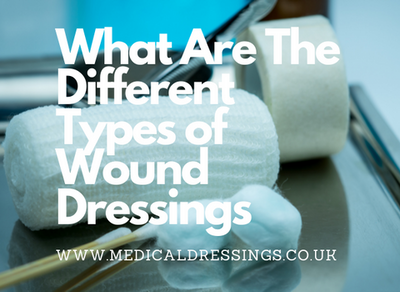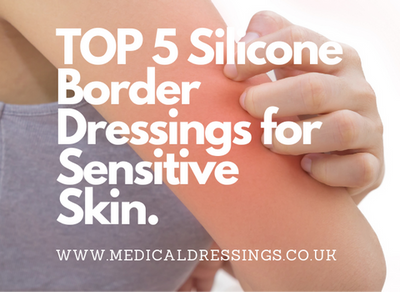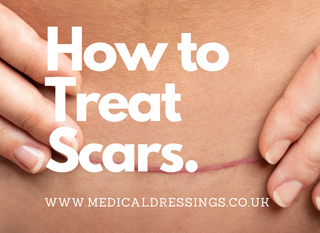Posted by James Hoad on 1st Oct 2022
Caring for your wound is just as important as allowing time for it to heal. And determining the most appropriate wound care dressings you will need can ensure you stay free from infection, protects from more damage, and increases wound healing time. Let’s have a look at the different types of wound dressings and some things we should keep in mind for the proper care of an injury.
What is a wound dressing? A wound dressing is a composition of appropriate material that comes in contact with the wound to prevent any further damage. They help stop bleeding and allow the blood to start clotting. They absorb blood and other fluids. They help in the debridement of the wound, or removal of dead tissue. There are several factors you should consider when evaluating the type of dressing you will need.
- Age
- Skin type
- Wound type and size
- Location
- Severity
With over 3,000 types of dressings on the market today, it can be difficult knowing that your options are. This article will help you get more familiar with the most common types of wound care dressings and when each one is most appropriate. But if your injury is serious. We urge you to see your health care provider or go to A&E for wound treatment to avoid any complications. Now, let’s discuss the main types of wound dressings and their best uses.
Gauze Dressings
Gauze dressings, or cloth dressings, are the most commonly used and readily available wound dressings out there today. They can be made from woven or nonwoven silk, linen, polyester, rayon, or cotton causing them to be highly permeable. This type of material is non-occlusive meaning it does not seal on the skin, allowing blood, water, and air to easily pass through. This dressing easily helps the wound dry out, minimizing exudate, the fluid leaking from the wound.
Gauze dressings can come in many different shapes and sizes that can be easily adapted to fit the wound. There are sterile and non-sterile varieties. There are also those with or without an adhesive border. You can use it on anything from a small finger injury to a wound that extends across the body. There are pre-cut varieties in the form of squares, sheets, or packing strips, as well as long wraps that can be wrapped around a limb or cut to size.
- Gauze sponge: This type of gauze is typically made from 100% cotton, and is commonly used to absorb blood or other fluids. They are usually cheap, and are great for all-purpose use in the cleaning, dressing, packing, and prepping all types of wounds.
- Gauze bandage roll: Also used for all types of wounds, the gauze roll can be used as a first layer or added layer on a wound. The 100% cotton roll can be wrapped around limbs on the head and is especially useful for those wounds that are in an area that is not easy to dress.
Best Uses: We recommend gauze dressing for the protection of open wounds or broken skin which occurred from a minor injury. This could include a scraped elbow, a slightly uncomfortable cut, or injuries in delicate areas. The gauze is used as the first layer of protection, and sometimes the second layer to seal in the dressing. This is especially helpful in an area that is difficult to dress due to the material’s ability to conform to your body. Another use would be to cleanse the wound, as well as keep it free from infection. Due to the inexpensive nature of this material, it can be used for one-time or short-term use and then discarded.
Transparent Film Dressings
Transparent film dressings are clear polyurethane thin sheets that have an adhesive coating on one side that sticks to the skin. The coating sticks to the skin around the injury which is dry but does not adhere to the wound itself due to its reaction with the wound exudate.
Due to its thin nature, it is said to be one of the more comfortable kinds of dressings. Also contributing to its comfortability is its flexibility. Its high elasticity allows it to flex, making it possible to conform to a range of body contours. And because the film is clear, this allows you to easily see the area and to gauge the progress of its healing without removing it. Transparent films allow your wound to stay clean from bacteria, which means less infection and speeding up the healing process.
Best Uses: Transparent film dressings can be used as either a first or second securement layer on the injury. This is a commonly used dressing that a doctor will apply when they want to keep track of a wound. This often includes larger, more complicated injuries like burns, ulcers, surgical incisions sites, skin graft donor sites, and IV sites. Being able to see the site allows the doctor to easily identify any potential complications earlier, like infections.
Hydrogel Dressings
Hydrogel dressings are meant to soothe wounds, reduce pain, help heal, and fight infection. This wound dressing is made of 80 to 99% water or glycerine, adding moisture to dry wounds. By adding moisture to the area, Hydrogel dressings enable faster healing by breaking down tissue that is dry and dead and promoting cell growth. Hydrogel dressings can’t absorb much fluid and therefore aren’t effective for a lot of injuries. Coming in the form of gels, sheets, or impregnated gauzes (gauzes saturated with the solution), the dressing when applied will feel cool and can even decrease the pain. Compared to some other options, hydrogel dressings are not as effective at warding off bacteria due to their permeability of gas and water. Additionally, they can quickly dehydrate, especially the water-based ones. Hydrogel dressings are often Non-Adhesive and will need another dressing on top to secure it.
Best Uses: Hydrogel dressings are best used for dry wounds that need to heal, as well as those with eschar. It is best used for those injuries which have little to no fluid excreted. It is also helpful to use hydrogel dressings for wounds that are especially painful. Because of their ability to promote cell growth brought on the added moisture, hydrogel dressings are ideal for second-degree burns, pressure ulcers, donor sites from skin grafts, as well as wounds that have become infected.
Foam Dressings
Foam dressings are made of foamed polymer, usually polyurethane, and made into sheets or other shapes. They have open cells which can hold fluids, enabling absorbency. But the extent of absorbency is based on the thickness and composition of the foams. Foam dressings absorb the excess fluids as well as keep the area moist at the same time, allowing for faster healing as well. The ultra-soft nature of the material also helps cushion the injury, protecting it from further harm.
These dressings can sometimes come pre-soaked in solutions or combined with other materials. Foam dressings come in many shapes and sizes. They can easily be removed because the contact with the wound is Non-Adhesive. Foam dressings can come with an adhesive border, often with a coating of a protective transparent film that helps prevent bacteria from entering but allows water vapor to enter. This aids in maintaining adequate moisture for the wound’s healing.
Best Uses: Foam dressings help prevent bad odours, as well as moderate to heavy discharge. They are ideal for both partially-thick and full-thickness wounds, and both serious and unserious wounds. You can also use foam dressings for pressure injuries.
Hydrocolloid Dressings
Hydrocolloid dressings are made up of hydrophilic colloidal particles. These can include gelatine, pectin, and cellulose. These materials allow for flexibility, which means greater comfort for all skin types. The wound dressings have secure backings made up of a film or foam self-adhesive, making them non-breathable, not to mention easy to apply. By creating a sealed, moist wound environment, hydrocolloids can keep the wound clean, prevent infection, and speed up the healing process.
There are different types of hydrocolloid dressings, which means they also have different levels of absorption. Coated with polysaccharides and other polymers, the dressing absorbs slough and exudate, and then slowly swells into a heap of gel-like matter. Once you remove the heap (which is biodegradable), there will be some residue left on the wound bed which may have a bad smell to it. Oftentimes this smell is thought to be the indication of an infected injury.
You can find hydrocolloid dressings in varying shapes and sizes. There are some which include bevelled edges, which add grip to the skin to keep it from rolling up. Using this type of dressing will insulate the area and keep it from water, oxygen, or bacteria from coming through. People using hydrocolloids as their wound dressing have much lower rates of infections than many other dressings out there. This includes gauze, semi-permeable films, semi-permeable foams, and sheet hydrogels. Not only do they have a good track record in preventing infections, but hydrocolloids also are one of the longest-lasting kinds of dressings.
Best Uses: You can use hydrocolloid dressings for burns, necrotic injuries, with compression wraps, wounds with light to moderate drainage, and on venous or pressure ulcers. They are effective for autolytic debridement.
Calcium Alginate Dressings
Calcium alginate dressings are made of brown seaweed fibres and sodium, making them biodegradable. Calcium alginates can absorb up to twenty times its weight. This high absorbency makes it ideal for sucking out the moisture from a deeply tunnelled wound. Like hydrocolloids, alginates react with the exudate, creating a gel-like substance which enables the injury to heal quicker.
This gel seals a moist environment that traps some bacteria. The smell of this reactive bacteria may be a foul odour once you remove the gel, but can be easily washed away. This odour can sometimes be mistaken for an infection. These permeable, nonocclusive dressings often require the assistance of another dressing to cover it, being gauze. You can find alginates in three varieties:
- Sheets: These may be put on the wound bed to absorb the draining fluids.
- Ropes: This variety tightly fills tunnels or areas under the skin which have become eroded, i.e. areas of undermining.
- Applicators: With tips of alginate, applicators are used to probe the lesion, occupy cavities and tunnels, to obtain swab cultures, and to measure the depth of the wound.
Sometimes used interchangeably with alginates are hydrofibers. These are dressings made of sodium carboxymethylcellulose and are extremely similar in its appearance and effects.
Best Uses: These macroalgae can be very absorbent, which makes it perfect for those wet injuries which have a lot of drainages. This means extreme or deep wounds, including burns, packing wounds, venous ulcers, or higher-state pressure ulcers. Alginate dressings need to be changed often due to the amount of fluid they will absorb. This could mean at least every two days. We recommend consulting your doctor if you think they may need to be changed more or less frequently, depending on the severity of your injury. If the dressing is changed too much, it could lead to too much dryness, which equates to a bigger possibility for harmful bacteria to enter.
Alginate dressings do not work well for wounds that are dry because they would create an even drier environment, making the time to heal even longer.
Composite Non-Adherent Dressings
Composite dressings, also known as combination dressings, are multi-layered. They can be used as either the primary dressing or secondary dressing. Typically, the composite dressing consists of three layers:
- 1.Inner layer: The contact layer is Non-Adherent, which keeps the injury safe during dressing changes.
- 2.Middle layer: This layer is absorptive, taking away moisture from the wound to avoid maceration, but still keeping the environment hydrated. This layer can be made of alginate, hydrogel, semi-permeable foam, or hydrocolloid.
- 3.Outer layer: A barrier for bacteria, this protective outer layer is imperative for the prevention of infection. It is often made of a semi-permeable film.
Best Uses: These dressings don’t have as many uses as many other types, due to their pre-packaged nature. However, they can be used on light to heavy wounds. Be extra careful if you have dry or sensitive skin. Check with the manufacturer to be sure the composite dressing can be used on an infected wound site.
Collagen Dressings
Collagen dressings are a bit different than most other dressings because they act as a temporary second skin. Having this second skin enables new cells to accumulate, grow, and become sustainable. Without such a dressing, the amount of time that the wound would heal would take much more time. Not only that, but collagen helps with the removal of dead tissue, the formation of new blood vessels, and the tightening of the edges of the site.
Best Uses: Collagen dressings are mostly used for chronic wounds that have a very slow or completely stalled rate of healing. You can use them on transplant sites, pressure sores, burns, ulcers, surgical sites, or large surface area injuries.
Silicone Dressings
Silicone is a common synthetic polymer that has a lot of applications in this day and age. In dressing form, soft silicone is tacky, allowing it to form a tight seal that repels water. The tackiness of the silicone allows it to be reapplied several times without losing its adhesion. It will not stick to the wound though, and will not create further damage. Additionally, silicone has anti-bacterial properties and is adhesive to even fragile or dry skin.
Silicone dressings are comfortable, and reduce pain and trauma in injuries during the changing of dressings. It doesn’t leave a residue, making it easy to work with. Though they can be helpful in wound dressing, they can be expensive.
Best Uses: Topical silicone gel sheets are said to prevent keloids or excessive scar tissue. This happens through the prevention of moisture penetrating the wound. With less moisture, there is less blood flow and therefore less collagen in the area. Since collagen is the material scars are made of, the absences of it will cause the skin to be paler, making the scar less apparent.
Improve Healing
We hope that this information we’ve provided has given you an idea of what types of wound care dressings are right for you. Wound management is imperative to ensure the proper healing of your injury. Here is a quick summary of our 9 types of dressings:
Gauze can be used on any part of the body and is the most permeable. Transparent films are helpful in the monitoring of a wound. Hydrogels help with pain and work best on dry sites. Foams work with bad odours and lots of discharge. Hydrocolloids help prevent infections and last the longest. Calcium alginates are highly absorbent and are critical in the care of deep wounds. Composites are multi-layered and can be used on cases ranging in severity. Collagen dressings work as a second skin for those slow-healing wounds. Silicone can help in the prevention of scarring.
Now that you know a wider variety of products that can be used for wounds besides Band-Aids, you can utilize this knowledge for better healing.



